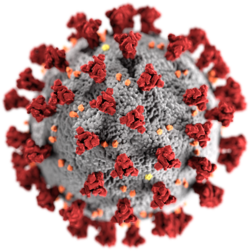SARS-CoV-2 cycle
Přisuzování:
Obrázek je označen jako „Vyžadováno uvedení zdroje“ (Attribution Required), ale nebyly uvedeny žádné informace o přiřazení. Při použití šablony MediaWiki pro licence CC-BY byl pravděpodobně parametr atribuce vynechán. Autoři zde mohou najít příklad pro správné použití šablon.
Formát:
3678 x 2011 Pixel (1660118 Bytes)
Popis:
Glycoprotein S, located in the virus envelope, interacts with the cellular receptor ACE2 and the virus enters the host cell by endocytosis. Once in the endosome, a lysosome-mediated pH drop occurs, promoting fusion of the endosome membrane with the virus envelope, releasing the nucleocapsid into the cytoplasm. Cellular proteases degrade the capsid and the virus genome is left free in the cytoplasm. Next, being a positive-sense RNA genome, the cellular machinery directly translates the polyproteins, which are then processed and the replication and transcription complex is formed. The complementary strand of negative-sense pre-genomic RNA is then synthesized and serves as a template to replicate the positive-sense viral genome. Furthermore, replication and transcription complex synthesized a number of smaller, positive-sense subgenomic RNAs, which are translated into viral proteins. This entire process occurs in the cytoplasm of the cell. The structural proteins are synthesized in the endoplasmic reticulum where assembly subsequently occurs. In fact, the virus envelope comes from the endoplasmic reticulum membrane. The viral particle travels to the surface, through the cellular vesicle transport system in which the Golgi apparatus intervenes. The viral particle leaves the cell by exocytosis. After a final phase of maturation, in which viral proteases are involved, all the components of the virus fit together, the particle is infectious and a new cell cycle may begin.
Reference: SARS and MERS: recent insights into emerging coronaviruses.
de Wit E, van Doremalen N, Falzarano D, Munster VJ. Nat Rev Microbiol. 2016 Aug;14(8):523-34. doi: 10.1038/nrmicro.2016.81.
https://www.nature.com/articles/nrmicro.2016.81#MOESM6
Více informací o licenci na obrázek naleznete zde. Poslední aktualizace: Mon, 29 Jan 2024 09:25:29 GMT
Relevantní obrázky
Relevantní články
SARS-CoV-2
SARS-CoV-2 je taxonomický ráz či vnitrodruhový klad virového druhu s mezinárodním taxonomickým názvem Severe acute respiratory syndrome-related coronavirus. Jedná se o RNA koronavirus, který způsobuje onemocnění covid-19, jež bylo poprvé pozorováno na konci roku 2019 v čínském městě Wu-chan. Nyní je osmým známým lidským koronavirem. Sekvenční analýza odhalila, že patří do stejného druhu jako SARS-CoV, tedy virus způsobující nemoc SARS. Od SARS-CoV se nový virus liší v sekvenci některých virových proteinů, které potlačují antivirovou imunitu a aktivují inflamazóm.
.. pokračovat ve čtení















